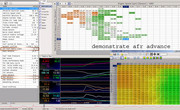Hi everyone. Long time listener, first time caller. I just jumped into LS tuning. I built and tuned a Megasquirt 15 years ago, and just dusted off the DIY WB I built at the same time. It still works great. I ran it through the EGR and I am ready to play.
The car is a 2007 BMW X3 with a 5.3L, 6 spd. I milled the heads to gain 1 point of compression, and installed the Summit stage 3 Pro LS cam with 232 degrees duration.
Fuel injectors are from 2001 Corvette, Bosch 12561462 (28lb/hr)
I have a short commute and I am driving the car to work. It drives decent, but surges a lot. It will idle sitting still, but hunts and when I throw in the clutch at a light I have to pedal it to keep it from dying.
I did not originally intend to tune it myself, so a while back I sent the computer off to Wait4me and that is where my tune started.
I have been researching a ton and still can't figure out if I should focus on the idle first or the fuel. I tried the idle setup tips in the sticky and it made it surge worse so I undid them and decided to work on the MAF, but my fuel is clearly jacked up.
Just tonight I disabled closed loop and dynamic airflow, and as I went to turn the high RPM disable down to 100 RPM, I found that wait4me already turned it down to 400. The stock tune is at 4000. I found that interesting.
Anyway, I just went and logged and not only is my spark erratic, but my AFR also jumps around a lot. I'd love it if someone could take a look and see if some obvious things jump out at your trained eyes? I am excited to fine tune, but if I knew I was going to tune it, I wouldn't have installed the cam until I learned more. I think I attached the necessary files. I don't have a lot of PID channels chosen. Let me know if I am missing critical channels. Thanks for reading!




 Reply With Quote
Reply With Quote

